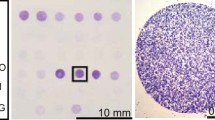Abstract
Two new monoclonal antibodies--BNH9 and BNF13--were generated by using a human lung adenocarcinoma cell line and standard hybridoma techniques. Both were found to react with epithelial and endothelial cells in routinely fixed and embedded tissues. Unexpected membrane labelling of some large cell lymphomas while non-reacting with normal lymphoid cells, prompted further characterisation. The antibodies were found to recognise red blood cell-related oligosaccharide antigens. The specificities were directed towards H and Y determinants. A distinctive pattern of reactivity was found for BNH9 in studying 480 cases of various lymphoid neoplasms. Strong expression of H and/or Y antigens was observed in 65/127 (51%) cases of anaplastic large cell(ALC) (CD30+) lymphomas, which are also known to co-express epithelial membrane antigen (EMA) frequently. Only a minority (less than 6%) of other non-Hodgkin's lymphomas (NHL) (CD30-,EMA-; 208 cases) and Hodgkin's disease (HD) (CD30+, EMA-; 126 cases) were positive. Expression of H and Y antigens was inducible on normal lymphocytes by mitogenic stimulation and by Epstein-Barr virus infection. The data suggest remarkable biological differences of ALC lymphomas within NHL and from HD.
Similar content being viewed by others
Author information
Authors and Affiliations
Rights and permissions
About this article
Cite this article
Delsol, G., Blancher, A., al Saati, T. et al. Antibody BNH9 detects red blood cell-related antigens on anaplastic large cell (CD30+) lymphomas. Br J Cancer 64, 321–326 (1991). https://doi.org/10.1038/bjc.1991.299
Issue Date:
DOI: https://doi.org/10.1038/bjc.1991.299
- Springer Nature Limited
This article is cited by
-
T-cell lymphomas, a challenging disease: types, treatments, and future
International Journal of Clinical Oncology (2017)
-
Anaplastic Large Cell Lymphoma: The Shifting Sands of Diagnostic Hematopathology
Modern Pathology (2001)
-
High concentration of leptin stimulates myeloid differentiation from human bone marrow CD34+ progenitors: potential involvement in leukocytosis of obese subjects
International Journal of Obesity (2000)
-
Recognition of the blood group H type 2 trisaccharide epitope by 28 monoclonal antibodies and three lectins
Glycoconjugate Journal (1996)




